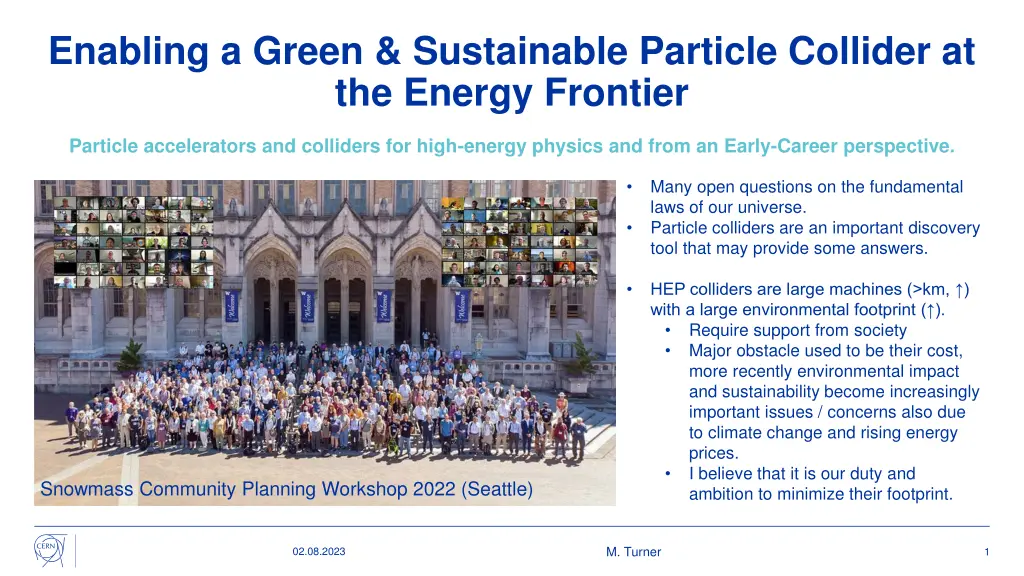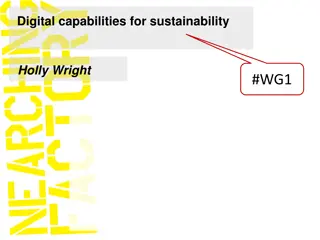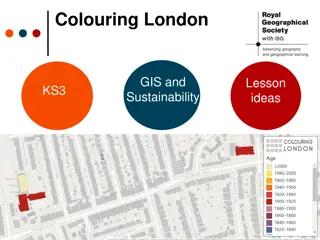
Sustainable Particle Collider Innovations: Energy Frontier Perspectives
Explore the challenges and opportunities in enabling green and sustainable particle colliders for high-energy physics from an early-career perspective. Dive into the environmental footprint, energy consumption, and sustainability efforts in operating particle colliders. Discover strategies for reducing energy consumption, maximizing efficiency, and minimizing carbon footprint in future collider projects.
Download Presentation

Please find below an Image/Link to download the presentation.
The content on the website is provided AS IS for your information and personal use only. It may not be sold, licensed, or shared on other websites without obtaining consent from the author. If you encounter any issues during the download, it is possible that the publisher has removed the file from their server.
You are allowed to download the files provided on this website for personal or commercial use, subject to the condition that they are used lawfully. All files are the property of their respective owners.
The content on the website is provided AS IS for your information and personal use only. It may not be sold, licensed, or shared on other websites without obtaining consent from the author.
E N D
Presentation Transcript
Enabling a Green & Sustainable Particle Collider at the Energy Frontier Particle accelerators and colliders for high-energy physics and from an Early-Career perspective. Many open questions on the fundamental laws of our universe. Particle colliders are an important discovery tool that may provide some answers. HEP colliders are large machines (>km, ) with a large environmental footprint ( ). Require support from society Major obstacle used to be their cost, more recently environmental impact and sustainability become increasingly important issues / concerns also due to climate change and rising energy prices. I believe that it is our duty and ambition to minimize their footprint. Snowmass Community Planning Workshop 2022 (Seattle) M. Turner 02.08.2023 1
Powering CERNs Accelerators CERN uses: 1.3 terawatt hours of electricity annually CERN uses about 80-200 megawatts of power When in operation, the LHC is responsible for some 55% of CERN s energy consumption. For Reference: The total electrical energy production in the world is around 20000 TWh, in the European Union 3400 TWh, Power plants: ~1 GW for a typical nuclear power plant ~500 MW for coal power plants What are the main drivers (intrinsic losses, relations between performance and consumption)? How to reduce consumption? The CERN accelerator complex (Image: CERN) M. Turner 02.08.2023 2
A Glimpse into the Future Trend is clear: larger colliders, more energy consumption, more costly, more complex [MW] Higgs factory CLIC 3 TeV lepton Especially future energy frontier machines will likely require even more power and energy to operate energy. Can we justify building a power plant for a collider? center of mass > 10 TeV From Snowmass ITF report M. Turner 02.08.2023 3
Recent Strategy Reports Highlight Sustainability as a Key Issue Snowmass 2021 Report: European Strategy 2022 Accelerator R&D Roadmap: We need to give high priority to the realisation of sustainable concepts, particularly when the next generation of large accelerator-based facilities is considered Given the high beam power, maximization of the efficiency of future accelerators is mandatory to guarantee the sustainability and affordability of the research conducted with these machines in view of reducing the carbon footprint and contain the operation costs, particularly in the present international context of increasing energy prices. A carbon footprint analysis in the design phase of a new facility can help to optimise energy consumption for construction and operation. Presenter | Presentation Title 17.06.2025 4
Work package 1.7 Sustainability and Environmental Impact (Advanced Accelerator Community) D. Voelker (DESY) M. Turner (CERN) Proposed scope of work 1. Development of guidelines that allow comparison of the environmental impact of proposed collider design. 2. Application of the developed guidelines for the environmental impact comparison to proposal. 3. Communicate, share and spread analysis results. Establish platforms that enable networking, exchanges and cooperation between accelerator physics, other scientific areas and industry. 4. Identify highest impact R&D that would allow to reduce the environmental footprint of future accelerators.
Examples of Efforts to Reduce Consumption & Environmental Impact Energy Recovery Idea: reuse energy stored in beams instead of dumping them. Shorter tunnels (more compact accelerators) Tunnel found to be the largest CO2 footprint for CLIC 3 TeV Novel accelerator technologies (plasma, muons, ) From 2022 Accelerator R&D Roadmap : Low loss superconducting resonators, efficient radio-frequency sources, permanent magnets, highly efficient cryogenic systems, superconducting electrical links Careful choice on what materials are used in what quantities and how these materials are sourced. Improvements could also benefit current accelerators M. Turner 02.08.2023 6
Conclusions My personal opinion: it would be exciting to have a next generation collider dedicated to fundamental science. Trade off between environmental footprint and physics. Need to understand key drivers. Crucial to have societal support: Biggest issue used to be cost, environmental impact is becoming increasingly important due to climate change and rising energy costs. We must make efforts to minimize the environmental footprint of accelerator construction and operation. Developing more efficient accelerators will require extensive R&D efforts. Sustainability recognized as key issue in many recent strategy and planning processes. M. Turner 02.08.2023 7






















